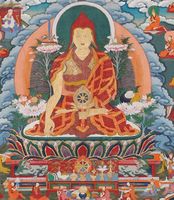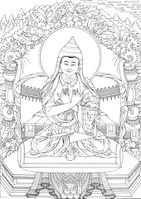Difference between revisions of "TA ra nA tha"
Jump to navigation
Jump to search
| Line 5: | Line 5: | ||
|HasDnzPage=Yes | |HasDnzPage=Yes | ||
|HasBnwPage=Yes | |HasBnwPage=Yes | ||
| + | |MainNameTib=ཏཱ་ར་ནཱ་ཐ་ | ||
| + | |MainNameWylie=tA ra nA tha | ||
| + | |MainNameSkt=Tāranātha | ||
|PersonType=Classical Tibetan Authors | |PersonType=Classical Tibetan Authors | ||
|images=File:Taranatha.jpg | |images=File:Taranatha.jpg | ||
File:Taranatha Kunga Nyingpo.jpg | File:Taranatha Kunga Nyingpo.jpg | ||
File:Taranatha (R. Beer).jpg{{!}}Line Drawing by Robert Beer Courtesy of [http://www.tibetanart.com/ The Robert Beer Online Galleries] | File:Taranatha (R. Beer).jpg{{!}}Line Drawing by Robert Beer Courtesy of [http://www.tibetanart.com/ The Robert Beer Online Galleries] | ||
| − | | | + | |BdrcLink=https://www.tbrc.org/#!rid=P1428 |
| − | | | + | |BdrcPnum=1428 |
| − | | | + | |TolLink=http://treasuryoflives.org/biographies/view/Taranatha/TBRC_P1428 |
| − | | | + | |tolExcerpt=In the history of the Jonang tradition Tāranātha is second in importance only to Dölpopa himself. He was responsible for the Jonang renaissance in U-Tsang during the late sixteenth and early seventeenth centuries, and the widespread revitalization of the zhentong teachings. Like his previous incarnation, Kunga Drolchok, Tāranātha practiced and taught from many different lineages and was nonsectarian in his approach to realization. He was also one of the last great Tibetan translators of Sanskrit texts. The abbot of Jonang Monastery, he emphasized the practice of the Sakya teachings of Lamdre and the esoteric instructions of the Shangpa Kagyu, but he specially focused on the explication of the Kālacakra Tantra and the practice of its Six-branch Yoga as the most profound of all the teachings given by the Buddha. It is clear in his writings that Tāranātha considered Dölpopa to be the ultimate authority in matters of doctrine and practice. |
|AltNamesWylie=kun dga' snying po | |AltNamesWylie=kun dga' snying po | ||
|AltNamesTib=ཀུན་དགའ་སྙིང་པོ་ | |AltNamesTib=ཀུན་དགའ་སྙིང་པོ་ | ||
| Line 24: | Line 27: | ||
|ReligiousAffiliation=Jonang | |ReligiousAffiliation=Jonang | ||
|EmanationOf=Kun dga' grol mchog | |EmanationOf=Kun dga' grol mchog | ||
| − | |StudentOf=Buddhagupta; Karmapa, 9th | + | |StudentOf=Buddhagupta; Karmapa, 9th |
| − | |||
| − | |||
| − | |||
| − | |||
|PosBuNayDefProv=Definitive | |PosBuNayDefProv=Definitive | ||
| + | |BuNayDefProvComplex=No | ||
|PosAllBuddha=Yes | |PosAllBuddha=Yes | ||
|PosWheelTurn=Third Turning | |PosWheelTurn=Third Turning | ||
| + | |BuNayWheelTurnComplex=No | ||
|PosYogaMadhya=Madhyamaka | |PosYogaMadhya=Madhyamaka | ||
| + | |BuNayYogaMadhyaComplex=No | ||
|PosZhenRang=Zhentong | |PosZhenRang=Zhentong | ||
| + | |BuNayZhenRangComplex=No | ||
| + | |BuNayVehiclesComplex=No | ||
|PosAnalyticMedit=Meditative Tradition | |PosAnalyticMedit=Meditative Tradition | ||
| + | |BuNayAnalyticMeditComplex=No | ||
|PosEmptyLumin=Tathāgatagarbha as the Emptiness That is an Implicative Negation (with enlightened qualities) | |PosEmptyLumin=Tathāgatagarbha as the Emptiness That is an Implicative Negation (with enlightened qualities) | ||
| + | |BuNayEmptyLuminComplex=No | ||
|IsInGyatsa=No | |IsInGyatsa=No | ||
}} | }} | ||
Latest revision as of 12:46, 14 October 2021
ཏཱ་ར་ནཱ་ཐ་
| Wylie | tA ra nA tha |
|---|---|
| Romanized Sanskrit | Tāranātha |
Other names
- ཀུན་དགའ་སྙིང་པོ་
- kun dga' snying po
Dates
| Birth: | 1575 |
|---|---|
| Death: | 1634 |
| Place of birth: | kha rag |
Tibetan calendar dates
| Day | |
|---|---|
| Month | |
| Gender | Female |
| Element | Wood |
| Animal | Pig |
| Rab Jyung | 10 |
About
- Religious Affiliation
- Jonang
- Is emanation of
- Kunga Drolchok
- Teachers
- Buddhagupta · Karmapa, 9th
Other Biographical info:
Links
- BDRC Link (P1428)
- https://www.tbrc.org/#!rid=P1428
- Treasury of Lives Link
- http://treasuryoflives.org/biographies/view/Taranatha/TBRC_P1428
- Wiki Pages
- TA ra nA tha on the DRL
- TA ra nA tha on the LIB
- TA ra nA tha on the RTZ
- TA ra nA tha on the DNZ
- TA ra nA tha on the BNW
Buddha Nature Project
- Person description or short bio
Expand to see this person's philosophical positions on Buddha-nature.
| Is Buddha-nature considered definitive or provisional? | |
|---|---|
| Position: | Definitive |
| Notes: | |
| All beings have Buddha-nature | |
| Position: | Yes |
| If "Qualified", explain: | |
| Notes: | |
| Which Wheel Turning | |
| Position: | Third Turning |
| Notes: | |
| Yogācāra vs Madhyamaka | |
| Position: | Madhyamaka |
| Notes: | |
| Zhentong vs Rangtong | |
| Position: | Zhentong |
| Notes: | |
| Promotes how many vehicles? | |
| Position: | |
| Notes: | |
| Analytic vs Meditative Tradition | |
| Position: | Meditative Tradition |
| Notes: | |
| What is Buddha-nature? | |
| Position: | Tathāgatagarbha as the Emptiness That is an Implicative Negation (with enlightened qualities) |
| Notes: | |
| Svātantrika (རང་རྒྱུད་) vs Prāsaṅgika (ཐལ་འགྱུར་པ་) | |
| Position: | |
| Notes: | |
| Causal nature of the vajrapāda | |
| Position: | |


